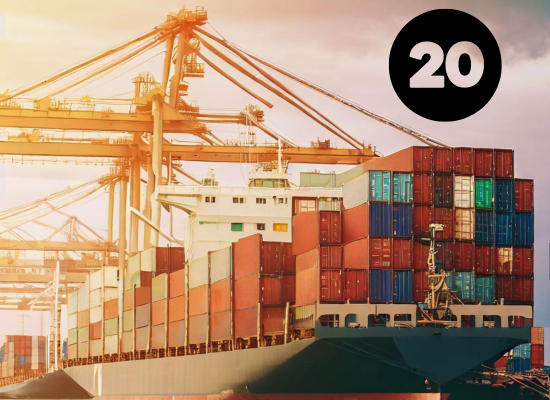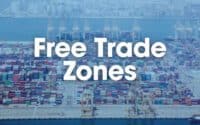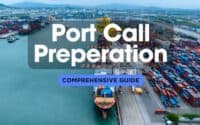Top 20 Busiest Ports in the World and What Makes Them Successful

These maritime hubs are more than just points of departure and arrival; they are dynamic ecosystems where technology, economy, and strategy converge to facilitate the seamless flow of goods across continents. From the bustling docks of Shanghai to the advanced terminals of Rotterdam, these ports exemplify the heights of efficiency, innovation, and connectivity. As we embark on a journey through the top 20 busiest ports in the world, let’s explore what makes these places so crucial to global trade and what secrets lie behind their success.
* Please send feedback/suggestions to editor @ shipuniverse.com
1. Port of Shanghai, China
The Port of Shanghai takes the crown as the busiest port in the world, a title it has held for several years. Its success can be attributed to a combination of its strategic location at the mouth of the Yangtze River, cutting-edge technology, and vast handling capacity. The port serves as a critical hub for international trade, linking major economic regions in Asia, Europe, and beyond.
Why It’s Unbeatable:
- Strategic Location: Situated at the crossroads of the Yangtze River delta, it is perfectly positioned to serve both international sea routes and the vast inland river system of China.
- Massive Capacity: With the world’s largest container terminal, it can handle a staggering volume of cargo, ensuring efficiency and speed in operations.
- Technological Innovation: The port utilizes state-of-the-art automation and smart technologies to streamline logistics and reduce turnaround times.
2. Port of Singapore, Singapore
Singapore’s port is a close second, renowned for its efficiency, robust infrastructure, and as a key node in global shipping. Its strategic position on the Strait of Malacca, one of the world’s busiest maritime trade routes, has been instrumental in its development into a global shipping hub.
Keys to Success:
- Strategic Geographic Advantage: Its location on major shipping lanes connects Europe, Asia, and the Middle East.
- Advanced Facilities: The port boasts some of the most advanced container terminals and logistics facilities in the world.
- Pro-Business Environment: Singapore’s pro-business policies, including favorable taxation and ease of doing business, significantly contribute to the port’s attractiveness to shipping companies and logistics operators.
3. Port of Ningbo-Zhoushan, China
The Ningbo-Zhoushan Port, resulting from the merger of Ningbo and Zhoushan ports, has rapidly climbed the ranks to become one of the busiest ports by cargo tonnage. This port stands out for its deep-water berths, extensive services, and strategic location that serves as a gateway to the interior provinces of China through the Yangtze River.
What Makes It Special:
- Comprehensive Services: Offering a wide range of services including container, bulk, and liquid cargo handling.
- Deep-Water Access: Capable of accommodating the world’s largest container ships with its deep-water berths.
- Strategic Integration: The merger has created synergies that enhance efficiency and capacity, making it a pivotal maritime logistics hub.
4. Port of Shenzhen, China
Located in the Pearl River Delta, the Port of Shenzhen is a collection of multiple container terminals that serve as a major gateway for China’s foreign trade. Its success is largely due to its proximity to Hong Kong, cutting-edge technology, and comprehensive logistics services that cater to an extensive hinterland.
Why It Stands Out:
- Strategic Proximity: Its location next to Hong Kong, one of the world’s major financial centers, provides unmatched logistical and supply chain efficiency.
- Technological Edge: The port is a leader in adopting technology, including automation and digitalization, to improve cargo handling and customs clearance.
- Versatile Services: It offers a wide array of services, handling everything from containers to bulk cargo, and has specialized terminals for different types of goods.
5. Port of Busan, South Korea
The Hub of Innovation and Efficiency
South Korea’s Port of Busan stands as a testament to the country’s technological prowess and strategic maritime positioning. As the busiest port in Korea and one of the largest in the world, Busan excels in handling a vast array of cargo with speed and efficiency.
What Sets It Apart:
- Technological Leadership: Embracing cutting-edge technologies for cargo handling and operations, Busan sets standards in efficiency and speed.
- Strategic Location: Positioned on the southeastern tip of the Korean Peninsula, it serves as a critical transshipment and logistics hub connecting Asia with the rest of the world.
- Extensive Network: With its vast array of shipping routes, Busan offers unparalleled connectivity, making it a preferred choice for international shippers.
6. Port of Hong Kong, China
A Legacy of Maritime Excellence
The Port of Hong Kong has long been celebrated as one of the world’s premier shipping centers, thanks to its deep, natural harbor and strategic location near the South China Sea. Despite facing competition, it remains a vital part of the global shipping industry.
Highlights of Success:
- Strategic Geographic Position: Its proximity to major manufacturing zones in Southern China and along the Pearl River Delta makes it a key logistic hub.
- World-Class Infrastructure: The port features some of the most sophisticated terminal facilities, capable of handling enormous volumes of cargo efficiently.
- Robust Services Network: Offering a wide range of logistics and shipping services, Hong Kong excels in providing comprehensive solutions to international traders.
7. Port of Guangzhou, China
An Ancient Port Modernized
As one of the oldest ports in the world that has continuously served the maritime trade, the Port of Guangzhou has seamlessly integrated modern facilities with its rich heritage. Today, it stands as a major player in international trade, particularly for China’s exports and imports.
Core Strengths:
- Extensive Facilities: With specialized terminals for containers, automobiles, and bulk cargo, Guangzhou can handle a diverse range of goods.
- Economic Integration: The port benefits from its position within the Pearl River Delta, one of the most economically vibrant regions in China, fostering trade and logistics.
- Innovation and Expansion: Ongoing investments in infrastructure and technology ensure the port remains competitive in the fast-evolving maritime sector.
8. Port of Qingdao, China
Blending Tradition with Modernity
The Port of Qingdao is renowned for its deep-water harbors, comprehensive logistics services, and strategic location on the Yellow Sea. It serves as a vital link in international trade routes, particularly between Asia and the rest of the world.
Defining Features:
- Versatile Operations: Capable of handling a wide variety of cargo types, including containers, bulk, and oil, Qingdao is a versatile maritime hub.
- Strategic Developments: Significant investments in port expansion and modernization have bolstered its capacity and efficiency.
- Global Connectivity: With numerous international shipping lines operating out of Qingdao, the port ensures global connectivity, facilitating trade across continents.
9. Port of Rotterdam, Netherlands
Europe’s Gateway to the World
The Port of Rotterdam is the largest port in Europe and a cornerstone of the European shipping industry. Known for its advanced infrastructure and strategic location at the mouth of the Rhine and Maas rivers, it serves as a major entry point for goods entering and leaving Europe.
Why It’s a Leader:
- Innovative Technology: The port is a pioneer in adopting digital solutions and automation to enhance efficiency and sustainability.
- Strategic Depth: Its location allows for the seamless movement of goods deep into the European continent, linking maritime routes with inland shipping, rail, and road networks.
- Comprehensive Services: Offering a wide array of services, from bulk and container handling to sophisticated logistics solutions, Rotterdam meets the diverse needs of international trade.
10. Port of Antwerp, Belgium
A Historic Hub with a Modern Twist
Close on the heels of Rotterdam, the Port of Antwerp is another key player in Europe’s maritime sector. Its success is attributed to its extensive network of inland connections, cutting-edge facilities, and its role as a leading chemical and petrochemical processing hub.
Distinctive Features:
- Strategic Location: Positioned at the heart of Europe, it provides unmatched access to major industrial and consumer markets.
- Versatile Facilities: Capable of handling a vast range of cargo types, including bulk, liquid, and containerized goods, with specialized terminals for chemicals.
- Innovation-Driven: The port is at the forefront of adopting eco-friendly technologies and processes, aiming for a carbon-neutral future.
11. Port of Dubai (Jebel Ali), UAE
The Middle East’s Premier Maritime Gateway
The Port of Jebel Ali, operated by DP World, is the largest port in the Middle East and a beacon of logistical excellence. It is renowned for its size, its free trade zone, and its strategic position as a gateway between East and West.
Key to Its Success:
- Massive Scale: The port boasts the largest man-made harbor in the world and one of the biggest container ports globally.
- Strategic Hub: Serving as a crucial link for cargo moving between Asia, Africa, and Europe, its strategic location ensures efficient transshipment and distribution.
- Integrated Free Zone: The Jebel Ali Free Zone (JAFZA) offers companies benefits like tax exemptions, custom duty benefits, and lacks restrictions on foreign ownership, attracting global businesses.
12. Port of Tianjin, China
Northern China’s Maritime Powerhouse
The Port of Tianjin is the largest port in Northern China and a vital maritime gateway for the Beijing-Tianjin-Hebei economic region. It stands out for its comprehensive services, advanced infrastructure, and strategic importance to China’s Belt and Road Initiative.
What Makes It Stand Out:
- Broad Capabilities: With facilities to handle a wide array of cargo, including general, bulk, and containerized freight, Tianjin caters to diverse logistics needs.
- Strategic Initiatives: The port plays a crucial role in China’s Belt and Road Initiative, enhancing its position as a global maritime hub.
- Environmental Focus: Emphasizing sustainable development, Tianjin has implemented measures to reduce carbon emissions and promote green shipping practices.
13. Port of New York and New Jersey, USA
A Gateway to the American Market
The Port of New York and New Jersey is the busiest on the East Coast of the United States and a vital artery for the American economy. It exemplifies how strategic location and robust infrastructure can create a premier maritime hub capable of handling immense volumes of cargo.
Why It’s a Key Player:
- Strategic Access: Its location provides unrivaled access to the most populous consumer market in the United States, along with efficient links to inland transportation networks.
- Versatile Facilities: With extensive facilities for container, bulk, breakbulk, and roll-on/roll-off cargo, it caters to a wide variety of shipping needs.
- Innovative Developments: Investments in technology and infrastructure, including deepening the harbor and raising the Bayonne Bridge, ensure it can accommodate the newest generation of mega-ships.
14. Port of Long Beach, California, USA
Innovation and Sustainability on the West Coast
Situated adjacent to the Port of Los Angeles, the Port of Long Beach is a pioneer in green shipping initiatives and a major player in trans-Pacific trade. Its ongoing commitment to environmental stewardship and operational excellence has set new standards in the maritime industry.
Defining Features:
- Environmental Leadership: With ambitious goals to cut emissions and a fleet of zero-emissions equipment, it’s at the forefront of sustainable port operations.
- Strategic Trade Link: As a critical endpoint for trans-Pacific trade, it facilitates a significant portion of the trade between the United States and Asia.
- State-of-the-Art Facilities: The port is equipped with some of the most technologically advanced terminals and equipment, designed to enhance efficiency and reduce environmental impact.
15. Port of Hamburg, Germany
Europe’s Gateway to the World
The Port of Hamburg, known as “Germany’s Gateway to the World,” is one of Europe’s busiest ports, celebrated for its efficiency and its strategic location on the Elbe River. It serves as a crucial link for the movement of goods between the sea and Europe’s inland waterways and rail networks.
Highlights of Success:
- Multimodal Connectivity: Exceptional links to rail, road, and inland waterway networks make it a key logistical hub in Europe.
- Technological Innovation: The port employs smart technologies and digital solutions to streamline operations and enhance cargo handling.
- Economic Importance: As a major economic driver for Germany, it plays a pivotal role in trade, especially in sectors like automotive, consumer goods, and electronics.
16. Port of Los Angeles, California, USA
A Titan of Trans-Pacific Trade
The Port of Los Angeles is not only the busiest port in the United States but also a fundamental component of global trade, particularly with Asia. Its extensive infrastructure, innovative approaches to maritime logistics, and strategic initiatives keep it at the apex of maritime commerce.
Why It’s Influential:
- Trade Volume: Handling immense volumes of cargo, it’s a critical gateway for international trade, especially between the U.S. and Asia.
- Infrastructure and Technology: The port’s advanced facilities and adoption of technologies like the Port Optimizer™ enhance its efficiency and capacity.
- Environmental Initiatives: A leader in sustainability, it has implemented measures aimed at reducing emissions and promoting clean energy solutions within maritime operations.
17. Port of Singapore, Singapore
The Smart Port at the Crossroads of Major Trade Lanes
Already highlighted for its pivotal role, the Port of Singapore bears mentioning again as it continues to set benchmarks for operational efficiency and innovation. As the world’s second-busiest port in terms of total shipping tonnage, it leverages its strategic location and cutting-edge technology to maintain its status as a global maritime leader.
Key Highlights:
- Strategic Location: At the crossroads of East-West trade lanes, its geographical advantage is unmatched, serving as a crucial transshipment and logistics hub.
- Innovation Hub: The port is a frontrunner in adopting smart technologies and automation to enhance port operations and security.
- Comprehensive Services: It offers a wide range of maritime services, including ship repair, bunkering, and logistics, supported by a pro-business environment and efficient customs.
18. Port of Shanghai, China
The World’s Busiest Container Port
The Port of Shanghai, with its world-leading container throughput, represents the pinnacle of maritime logistics efficiency and capacity. Its continuous expansion and embrace of technological advancements ensure it remains at the forefront of global trade.
Standout Features:
- Unmatched Capacity: Handling the highest volume of containers globally, its capacity for cargo is unparalleled.
- Strategic Positioning: Located at the Yangtze River Delta, it serves as a key maritime gateway for China’s bustling eastern region.
- Innovative Operations: From automated terminals to green initiatives, the port is a model of modern efficiency and sustainability.
19. Port of Ningbo-Zhoushan, China
A Maritime Powerhouse in Bulk and Container Shipping
Merging the strengths of Ningbo and Zhoushan ports, this port complex has quickly risen to prominence, particularly in bulk and container shipping. Its strategic initiatives and investments in infrastructure have made it a critical node in China’s maritime network.
Why It’s Among the Best:
- Versatile Cargo Handling: Excelling in handling a variety of cargo types, from containers to bulk commodities, it’s a linchpin in global supply chains.
- Strategic Location: Its position along the eastern seaboard of China offers direct access to the Pacific and beyond, enhancing its role in international trade.
- Infrastructure Investments: Ongoing expansions and upgrades in facilities ensure it can accommodate the ever-increasing demands of global trade.
20. Port of Rotterdam, Netherlands
Europe’s Foremost Logistics and Industrial Hub
As the largest port in Europe, Rotterdam is not just a port but a vast logistics and industrial complex that plays a pivotal role in the European and global economy. Its forward-thinking management and continuous innovation in sustainability and digitalization keep it at the cutting edge of port operations.
Distinct Advantages:
- Strategic Gateway: Its prime location and depth accommodate the largest vessels, acting as Europe’s gateway for cargo from and to the world.
- Innovative Ecosystem: The port is a leader in digitalization, using data analytics and AI to optimize logistics and operations.
- Sustainability Focus: With ambitious goals to become carbon neutral, it is pioneering in environmental stewardship among global ports.

Do you have a Maritime Product or Service that may be of interest to Shipowners? Tell us about it here!
Do you have feedback or insights? Please reach out to editor @ shipuniverse.com



